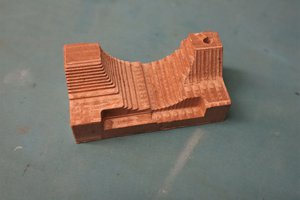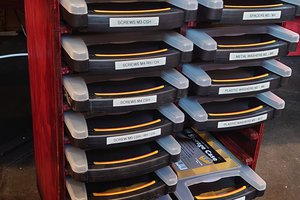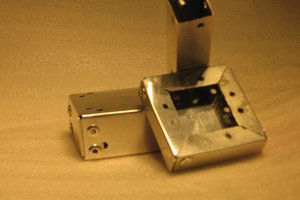The speaker box is formed by 7 different pieces. The corners (8 of them), front face, back face, 2 sides (one with Aladdin Sane's lightning bolt engraved, yes, I am a Bowie fan; and the other has an eight note engraved), top, and bottom.
I painted black the inner face of the 2 sides, top, and bottom, and I glued these four parts with epoxy based glue. The reason why I painted them, instead of keeping the parts translucent, is because I would put foam in all the inner faces, except the front face,and if the faces were clear it would look weird. In retrospect, I should have painted the back face too. I tapped a M3 thread on the holes of the corners, and glued the corners as well to the box (4 corners in the corners of the front face, and four in the corners of the back face). Once glued, I applied glue with a glue gun on the joints to ensure a good sealing (you could use silicone too).
The front and back face are screwed to the box, this is why I tapped the threads on the corners. I also used acrylic double tape or gasketing tape to have a better seal between the front face and the box, and the back face and the box.
Overall, the most critical parts of this project are the tolerances during the design and manufacturing. So first, know how much material the laser beam eats (around 0.1-0.2 mm, but depends on the cutter); second, do not cut the parts before measuring the thickness and size of your acrylic sheet, and all the components (especially the port tube and the tweeter, since they are press fitted into the box), then adjust the design to this measurements. Painting can be a critical part if you are not an expert painting; make sure to protect the edges with tape so that you won't paint the outer face. Finally when gluing, be careful not using excessive glue, if you have some glue on the exterior of the speakers you can remove that with ethanol (DO NOT use acetone).
The drawings that I posted are corrected after measuring, and taking into account the tolerances and the 0.2 mm that the laser beam eats when cutting. The acrylic sheet I ordered turned out to be 1/4 of an inch shorter, so the box, instead of being 6x6x9 in, it ended up being 5-7/8x6x9 in. Also, I made the holes for the screws on the front and back side bigger than 3 mm (around 4-5 mm) to have some play and flexibility to place all the parts and screws. The holes in the corner pieces are smaller than 2.5 mm (size of a hole to tap a M3), this is because, as I have stated before, the laser beam eats material, so If I would have draw a 2.5 mm hole, the final hole would have been 2.8-2.9 mm and then the M3 thread would be very bad. If you don't have an M3 tap you can buy M3 threaded inserts for plastic (or any other bolt size that you prefer, I always tend to use M3).
Also, you can use this link to design the speaker box https://www.diyaudioandvideo.com/Calculator/SpeakerBoxEnclosure/ . This website has other helpful calculators and explanations, like the crossover calculator.
I picked the size of the box based on the specs of the woofer. Then I designed the pot using the following link http://www.mobileinformationlabs.com/HowTo-1Woofer-Box-CAL%20Port%20lenth%201.htm. The advantages of using a ported Box instead of a sealed box is that you can reach lower frequencies (even lower that the minimum frequency in the specs of the woofer). The disadvantage, however, is that the ported boxes are bigger (twice the volume than a sealed box).

 Michael Perrone
Michael Perrone


 FiveseveN
FiveseveN